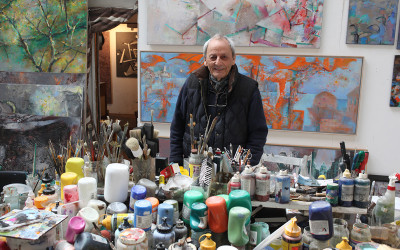
Anthony Whishaw RA, Bullfight With Falling Picador, 1951-52.
Oil on canvas. 1020 mm x 1290 mm. © The Artist. © Photo: Royal Academy of Arts, London.
This image is released under Creative Commons CC-BY-NC-ND
To licence this image for commercial purposes, contact our Picture Library at picturelibrary@royalacademy.org.uk
Bullfight With Falling Picador, 1951-52
Anthony Whishaw RA (b. 1930)
RA Collection: Art
In the summer of 1951, before his final year at the Chelsea School of Art, Whishaw travelled to Ibiza. This trip was the beginning of a lifelong passion for Spanish art and culture, through which Whishaw would draw inspiration from the work of Goya, Velázquez, Zurbarán and Picasso.
It was on this trip that Whishaw also experienced his first bullfight. As Richard Davey explains, ‘The pageantry and rituals of the bullfight provided Whishaw with a compelling narrative. Fascinated by the dynamic shapes of this visceral, raw spectacle he drew the horses and bulls, the matadors and the cheering crowds.’
On his return to England, Whishaw began this dramatic, geometric composition. Seen from behind, the bull’s massive, muscular form dominates the foreground. The picador’s lance sticks out from its right shoulder. As the bull lunges further into the depth of the painting, the picador’s horse rears up in fear. Its gaping mouth and flared nostrils face directly out towards us at the top of the painting, recalling the screaming horse in Picasso’s Guernica. Having been thrown from his horse, the rider still grips the reins as he is upturned on the left side of the canvas. The vivid, geometric bodies of both man and beast stand out against a brightly lit background, which throws the composition into dramatic chiaroscuro. As Davey observes, this reinforces ‘the drama and physicality of the scene’. [Davey, pp. 17-19]
References:
Richard Davey, Anthony Whishaw, (Royal Academy Publications, 2016)
Object details
1020 mm x 1290 mm
Start exploring the RA Collection
- Explore art works, paint-smeared palettes, scribbled letters and more...
- Artists and architects have run the RA for 250 years.
Our Collection is a record of them.



